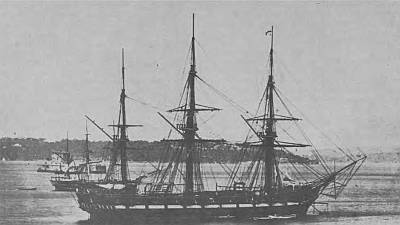- Author
- Cowburn, Professor P. M.
- Subjects
- None noted
- Tags
-
- RAN Ships
- None noted.
- Publication
- August 1972 edition of the Naval Historical Review (all rights reserved)

During the early part of this appointment Gowlland was chief assistant to a Captain Sidney, but in 1867 he took over the survey from him. By this time he had married the granddaughter of Simeon Lord, the pioneer merchant, and had probably decided to remain in the surveying branch of the Navy in Australia where there must have been the prospect of any amount of work. He was appointed staff commander in 1873, and he compiled the Admiralty charts of the Hawkesbury, Hunter and Clarence Rivers, but he was drowned at the age of thirty-six during surveying duties off Dobroyd Point near Sydney in 1874, though ‘not’, according to the Sydney Mail, ‘before he had done the state some service’.
Many examples might be selected to show the quality of the naval memoir, but perhaps the writings of Cyprian Arthur George Bridge are of particular interest. Bridge served three times on the Australian Station, first, but only briefly, in the early months of the Station’s separate existence, then again in the early 1880s as captain of the Espiegle and lastly as Commander-in-Chief, 1894-97. His book Some Recollections, published towards the end of a long and useful life, describes events experienced years earlier, but it is a valuable source in that much can be learnt from it about life on a naval station, while it should be remembered that the writer was a highly intelligent man, well read in several languages.
Bridge’s first visit to Australia seems to have been fortuitous. He had joined the wooden steam corvette Pelorus in 1857 as a midshipman when she was being commissioned by Captain Seymour Beauchamp to join a five-ship squadron on the China Station, an additional force thought necessary because of the Sepoy mutiny and the situation in China that was about to erupt in the second Opium War. In May 1859 Pelorus was ordered to Australia. There was ‘a warm and hearty reception’ for her in Sydney, and for a young officer there were plenty of diversions. Bridge liked the clubs in Sydney, several of which made the Pelorus’s officers honorary members, he listened to debates in the New South Wales Parliament, went to the opera at least once – Lucia di Lammermoor – and made friends with William Bede Dalley. He was impressed by Blackett’s newly completed Great Hall at Sydney University and thought the Sydney Morning Herald a very good newspaper. Commodore William Loring, however, was a strict disciplinarian and did not allow his officers to wear plain clothes when off duty on shore, and Bridge relates how he was nearly caught out thus attired in the Australasian Club, but just managed to conceal himself behind the capacious pages of The Times where he remained until the Commodore withdrew.
In 1881 Bridge was offered the command of HMS Espiegle, a full-rigged steam sloop then fitting out for service on the Australian Station. The chapters of his book that cover this commission are well-written, closely observed accounts of life in a part of the British world that owed a great deal to the Royal Navy.
Captain Bridge recognised that the islanders owed much to British naval officers, but he thought that the stories about the kidnapping of island labour were exaggerated. This is an important admission because it enables us to accept his views more readily since, in a sense, he was almost a hostile witness – or at least unlikely to overstress the illegalities of blackbirding. Thus, when Bridge writes of the ‘extreme delicacy of the position of a captain of one of Her Majesty’s ships ordered to cruise about the South Seas’, his reason for this judgement seems worthy of respect. Let us therefore take a closer look at what he says on this subject.
In Bridge’s view a naval officer was placed in something of a dilemma since ‘there was a public opinion in the dominions and a public opinion in the United Kingdom, neither of which he could afford to disregard; and the two opinions were not always the same’. Also he noted that ‘there were two sets of authorities, to one of which he owed obedience and to the other respect’. It was this ambivalence in his day to day relations with the labour traders, chiefs, Polynesians and other islanders that made the naval officer’s position such a difficult one. There were Europeans too, often his fellow-Britons, lotus-eating in the terrible beauty of some island that should have been, and perhaps once was, an aspect of paradise, but keeping wary eyes on the commercial advantages to be gained from every new development. Thus an officer on shore could not afford to lower his guard: in Bridge’s words, ‘the unwary, wanting to walk, shoot pigeons or collect specimens could land himself up in an incident in which reprisals were necessary’. Usually, naval training provided sufficient resourcefulness for dealing with most situations, but appearances could be deceptive as the following passage shows:




